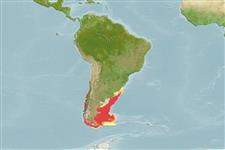Elasmobranchi (squali e razze) (sharks and rays) >
Rajiformes (Skates and rays) >
Rajidae (Skates)
Etymology: More on author: Guichenot.
Environment: milieu / climate zone / depth range / distribution range
Ecologia
marino demersale; distribuzione batimetrica ? - 40 m (Ref. 120403). Temperate; 4°C - 19°C (Ref. 104541); 18°S - 57°S, 75°W - 52°W
Southeast Pacific: central Chile to the Strait of Magellan.
Length at first maturity / Size / Peso / Age
Maturity: Lm 103.5, range 94 - 100 cm
Max length : 152 cm TL maschio/sesso non determinato; (Ref. 120403)
Short description
Morfologia | Morfometria
This medium-sized speies of Dipturus (up to at least 118.0 cm TL) is distinguished from its congeners by the following set of characters: when fresh, the dorsal surface of body is plain brownish to greyish, with some lighter small spots randomly distributed dorsally; one red to purple ocellus over center of each pectoral fin; ocelli with well-defined margins, irregular in shape, but often indistinguishable in fixed specimens; ventrally, white to grey with lighter patches over area of gill openings and beneath mouth; area flanking rostral cartilage membranous and slightly translucent and opaque and yellowish when fixed. Further differs by having a relatively broad disc with angular apices, its width 76.4 (75.0; 77.0) % TL; snout relatively short and broad; tail longer in males (42.2 [40.8] % TL) than in female voucher ([38.8] % TL); ventral head length 35.1 (34.2; 37.7) % TL; preorbital snout length 2.4 (2.9; 2.9) times distance between orbits; orbit diameter 0.5 (0.5; 0.6) of inter-orbital width; in males, the dorsal surface of disc and tail with central longitudinal band of dermal denticles extending from anterior margin of rostral cartilage to tail, including anterior margins of dorsal and caudal fins; a thin band of dermal denticles at anterior margins of pectoral fins, extending from anterior fontanelle to front line of alar thorn patches; dorsal surface of disc and tail of females covered with small dermal denticles, except for external margins of pectoral fins, pelvic fins, and area surrounding caudo-central thorns; with orbital thorns; a single nuchal thorn is often absent; both sexes without scapular thorns; a patch of malar thorns only in adult males; alar thorns only in adult males; medial-dorsal and lateral-dorsal thorns may be present in large specimens, especially in large females; small central-caudal thorns mostly arranged in longitudinal pairs in males and females, with two additional longitudinal rows of fine, sharp and posteriorly oriented lateral-caudal thorns may be present in large specimens; ventral sensory pores are small, distinct, black-edged, most abundant on snout and around mouth, scattered over area between gill openings, sparsely spaced on abdominal area and pectoral fins (Ref. 120403).
Oviparous (Ref. 50449). Reported size at hatching and incubation period 17.2 cm TL and 252 days, respectively (Ref. 120403). Eggs have horn-like projections on the shell (Ref. 205). Inhabits sandy and muddy bottoms at depths (Ref. 104541).
Life cycle and mating behavior
Maturità | Riproduzione | Deposizione | Uova | Fecundity | Larve
Oviparous, paired eggs are laid. Embryos feed solely on yolk (Ref. 50449). Eggs have horn-like projections on the shell (Ref. 205).
Concha, F.J., J. Caira, D.A. Ebert and J.H.W. Pomperi, 2019. Redescription and taxonomic status of Dipturus chilensis (Guichenot, 1848), and description of Dipturus lamillai sp. nov. (Rajiformes: Rajidae), a new species of long-snout skate from the Falkland Islands. Zootaxa 4590(5):501-524. (Ref. 120403)
IUCN Red List Status (Ref. 130435)
Threat to humans
Harmless
Human uses
Informazioni ulteriori
CollaboratoriImmaginiStamps, Coins Misc.SuoniCiguateraVelocitàModalità di nuotoArea branchialeOtolithsCervelliVista
Strumenti
Special reports
Download XML
Fonti Internet
Estimates based on models
Preferred temperature (Ref.
123201): 4.5 - 10.6, mean 6.7 °C (based on 334 cells).
Phylogenetic diversity index (Ref.
82804): PD
50 = 0.6250 [Uniqueness, from 0.5 = low to 2.0 = high].
Bayesian length-weight: a=0.00282 (0.00133 - 0.00596), b=3.25 (3.08 - 3.42), in cm total length, based on LWR estimates for this Genus-body shape (Ref.
93245).
Trophic level (Ref.
69278): 4.5 ±0.6 se; based on diet studies.
Generation time: 9.5 (8.1 - 12.6) years. Estimated as median ln(3)/K based on 13
growth studies.
Resilienza (Ref.
120179): Basso, tempo minimo di raddoppiamento della popolazione 4.5 - 14 anni (Fec assumed to be <100).
Fishing Vulnerability (Ref.
59153): Very high vulnerability (90 of 100).
Nutrients (Ref.
124155): Calcium = 3.18 [0.45, 55.95] mg/100g; Iron = 0.198 [0.018, 2.222] mg/100g; Protein = 15.2 [12.7, 18.3] %; Omega3 = 0.698 [0.304, 1.673] g/100g; Selenium = 18.6 [3.7, 89.1] μg/100g; VitaminA = 4.17 [0.30, 53.72] μg/100g; Zinc = 0.25 [0.02, 2.75] mg/100g (wet weight); based on
nutrient studies. 